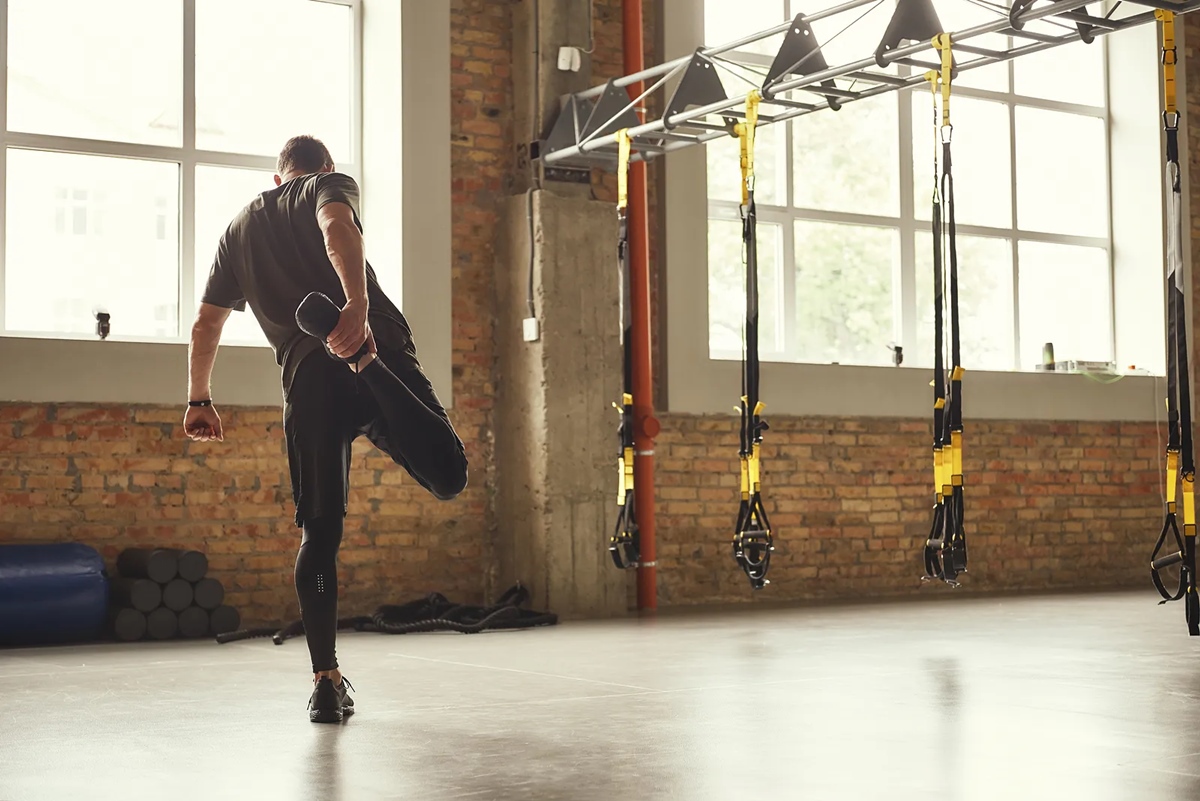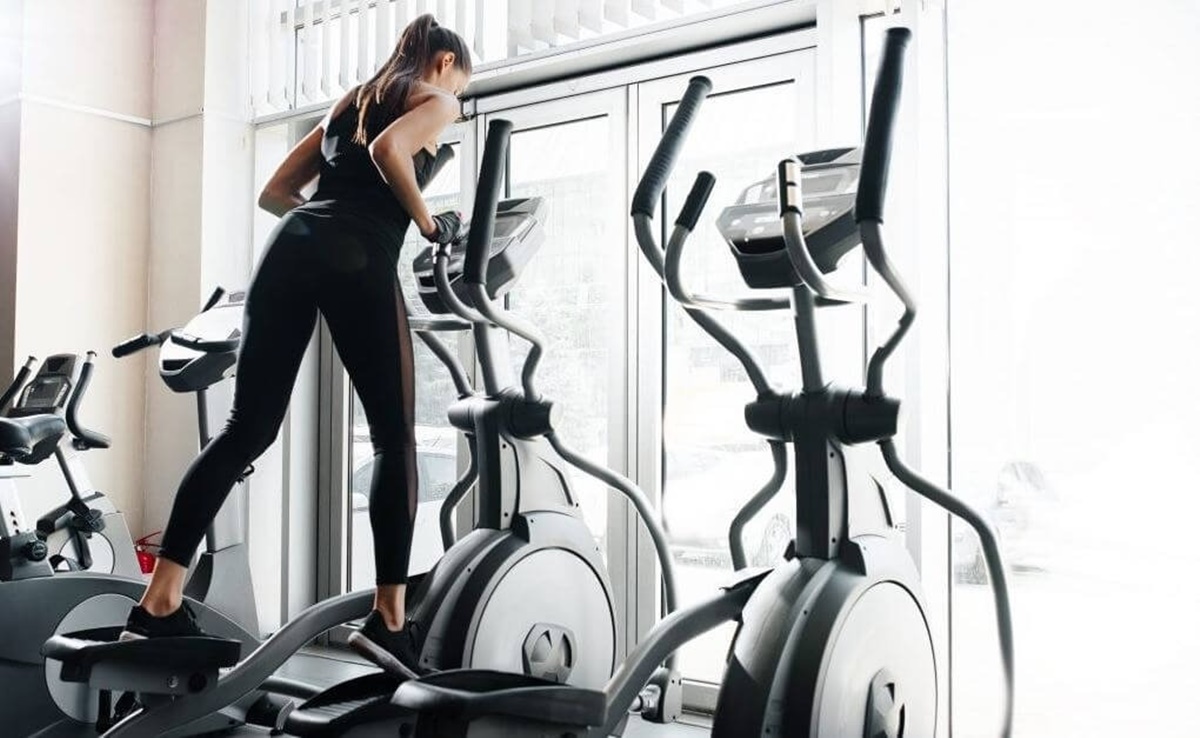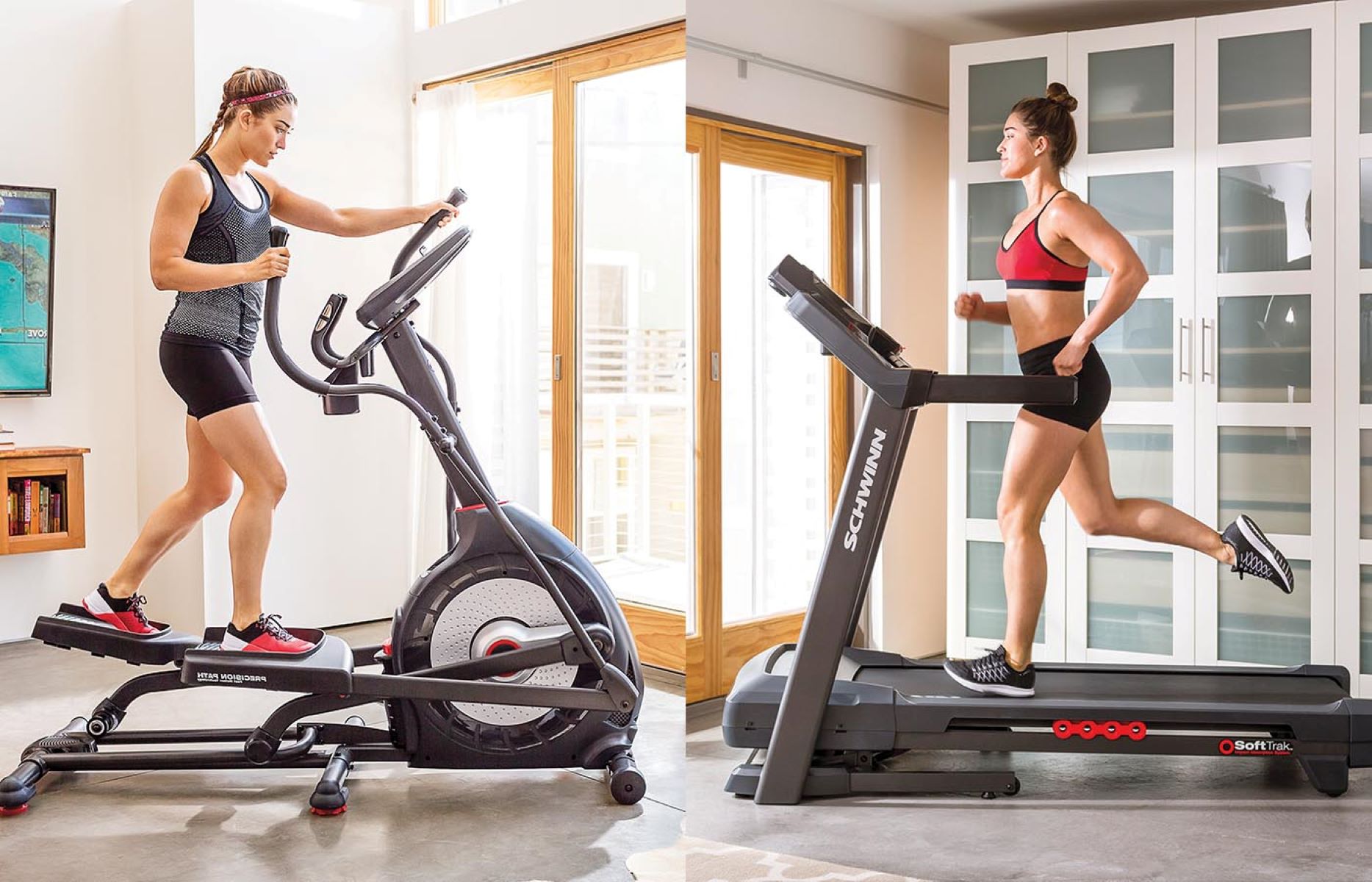Home>Misc>Featured>How To Stretch Before Elliptical Interval Training


Featured
How To Stretch Before Elliptical Interval Training
Modified: January 2, 2024
Get ready for your elliptical interval training with our featured guide on how to stretch properly beforehand. Maximize your workout and prevent injuries with these essential stretching techniques.
Introduction
Elliptical interval training is an effective and efficient way to enhance cardiovascular fitness, burn calories, and improve overall endurance. However, before hopping onto the elliptical machine and diving into your interval training session, it is important to properly warm up your muscles and prepare your body for the intense workout ahead. This is where stretching comes into play.
Stretching before elliptical interval training can help increase flexibility, improve blood flow to the muscles, reduce the risk of injury, and enhance performance during your workout. While some may argue that stretching is not necessary before cardio exercises like elliptical training, incorporating a stretching routine into your pre-workout ritual can have numerous benefits.
In this article, we will explore the benefits of stretching before elliptical interval training and provide you with some of the best stretches to incorporate into your warm-up routine. Additionally, we will share tips for effective stretching to ensure that you get the most out of your warm-up and reduce the risk of injury during your elliptical training sessions.
Benefits of Stretching Before Elliptical Interval Training
Stretching before elliptical interval training offers a range of benefits that can greatly enhance your workout experience. Here are some key advantages to incorporating stretching into your warm-up routine:
- Increased Flexibility: Stretching helps to improve the flexibility of your muscles and joints. This increased range of motion allows for a greater stride length and movement efficiency during your elliptical training, leading to improved performance.
- Improved Blood Flow: Stretching increases blood circulation to the muscles, providing them with the necessary oxygen and nutrients for optimal performance. This enhanced blood flow can also help reduce muscle soreness and fatigue during and after your workout.
- Reduced Risk of Injury: Proper stretching before your elliptical training can help reduce the risk of muscle strains, sprains, and other injuries. It prepares your muscles for movement and makes them more resistant to sudden stress and impact.
- Enhanced Performance: Stretching primes your muscles for the intense exercise ahead, improving your overall performance during elliptical interval training. It increases muscle coordination, allowing for smooth and efficient movement on the machine.
- Increased Mind-Body Connection: Stretching helps to create a mind-body connection by focusing your attention on your muscles and their movements. This can enhance your overall workout experience and help you stay present in the moment.
By taking a few extra minutes to stretch before your elliptical interval training, you can significantly improve your workout performance and reduce the risk of injuries. It is important to note that stretching alone may not be enough to prevent injuries, so it should be combined with other warm-up activities such as light cardio exercises to fully prepare your body for the workout ahead.
Best Stretches for Elliptical Interval Training
When it comes to stretching before elliptical interval training, there are specific stretches that target the major muscle groups used during the workout. Incorporating these stretches into your warm-up routine can help increase flexibility, reduce muscle tension, and prepare your body for the intense exercise ahead. Here are some of the best stretches for elliptical interval training:
- Quadriceps Stretch: Stand upright and hold onto a wall or a sturdy object for balance. Bend one knee and grab your ankle, pulling your heel toward your buttocks until you feel a stretch in your quadriceps muscle. Hold for 30 seconds and repeat on the other leg.
- Hamstring Stretch: Sit on the edge of a bench or chair, with one leg extended in front of you and the other bent with the foot flat on the floor. Lean forward from your hips with a straight back, reaching towards your extended foot. Hold for 30 seconds and switch legs.
- Calf Stretch: Stand facing a wall and place your hands on the wall for support. Extend one leg behind you, keeping it straight and pressing the heel into the floor. You should feel a stretch in your calf muscle. Hold for 30 seconds and switch legs.
- Hip Flexor Stretch: Step forward with one leg into a lunge position. Keep your back straight and tuck your tailbone under slightly. You should feel a stretch in the front of your hip. Hold for 30 seconds and switch sides.
- IT Band Stretch: Stand upright with your feet shoulder-width apart. Cross one leg over the other and lean to the side, stretching the outer part of your leg. Hold for 30 seconds and repeat on the other side.
- Chest and Shoulder Stretch: Stand upright and clasp your hands behind your back. Gently lift your arms up and away from your body, feeling a stretch in your chest and shoulders. Hold for 30 seconds.
- Back Stretch: Sit on the edge of a chair and cross one leg over the other. Twist your upper body towards the crossed leg, placing your opposite hand on your outer thigh for support. Hold for 30 seconds and switch sides.
- Triceps Stretch: Extend one arm overhead and bend it at the elbow, reaching your hand towards the opposite shoulder blade. Use your other hand to gently pull the elbow towards your head, feeling a stretch in the back of your arm. Hold for 30 seconds and repeat on the other arm.
Remember to perform each stretch slowly and gently, and only stretch to the point of mild discomfort, not pain. Hold each stretch for about 30 seconds and remember to breathe deeply throughout the stretching routine. Aim to complete these stretches before every elliptical interval training session to maximize their benefits.
Quadriceps Stretch
The quadriceps stretch targets the large muscles located at the front of the thigh, namely the quadriceps femoris. This muscle group is actively engaged during elliptical interval training, making it essential to stretch them properly before your workout. The quadriceps stretch helps increase flexibility in the quads, improves range of motion, and reduces the risk of injury. Here’s how to perform the quadriceps stretch:
- Stand upright and hold onto a wall or a sturdy object for balance.
- Bend one knee and grab your ankle with the corresponding hand, pulling your heel toward your buttocks.
- Keep your upper body tall and avoid leaning forward or backward.
- Hold the stretch for about 30 seconds while ensuring that you feel a gentle pull in the front of your thigh.
- Repeat the stretch on the other leg.
Make sure to maintain a controlled and steady motion throughout the stretch, without any sudden jerking or bouncing movements. If you find it difficult to reach your ankle, you can use a strap or towel to loop around your foot and hold onto it with your hand. This modification allows you to perform the stretch effectively even if you have limited flexibility.
Stretching the quadriceps before elliptical interval training helps warm up and prepare the muscles for the upcoming workout. Increasing blood flow to the quadriceps can improve their performance and overall function during your elliptical session. By including the quadriceps stretch in your pre-workout routine, you can reduce the risk of muscle strains and imbalances while promoting optimal muscle engagement and efficiency on the elliptical machine.
Hamstring Stretch
The hamstring stretch is a crucial stretch to include in your warm-up routine before elliptical interval training. The hamstrings, located at the back of the upper legs, play a significant role in hip extension and knee flexion, which are fundamental movements during elliptical workouts. Stretching the hamstrings prior to your exercise session can help increase their flexibility, improve range of motion, and prevent muscle strains. Here’s how to perform the hamstring stretch:
- Sit on the edge of a bench or chair, with one leg extended in front of you and the other leg bent with the foot flat on the floor.
- Lean forward from your hips, keeping your back straight, and reach towards your extended foot.
- Aim to feel a gentle stretch in the back of your thigh.
- Hold this position for about 30 seconds, breathing deeply and relaxing into the stretch.
- Switch legs and repeat the stretch on the opposite side.
It’s important to note that while performing the hamstring stretch, you should avoid rounding your back or forcefully pushing down to touch your toes. Instead, focus on maintaining proper posture and gradually increasing the stretch as your muscles allow. If you have tight hamstrings, you may find it helpful to bend your extended leg slightly or use a yoga block or folded towel to support your hands.
Stretching the hamstrings before elliptical interval training helps prepare the muscles for the movements involved in the workout. It enhances flexibility, allowing for greater range of motion and improved performance. Additionally, loosening up the hamstrings can help alleviate muscle tightness and reduce the risk of strains or pull during your elliptical session. Including the hamstring stretch as part of your warm-up routine will contribute to a more effective and injury-free workout experience.
Calf Stretch
The calf muscles, located at the back of the lower legs, are actively engaged during elliptical interval training. Stretching the calves before your workout is crucial for improving flexibility, reducing muscle tension, and preventing calf cramps or strains. The calf stretch targets both the gastrocnemius and soleus muscles, which are responsible for plantar flexion of the foot. Here’s how to perform the calf stretch:
- Stand facing a wall and place your hands on the wall for support.
- Extend one leg behind you, keeping it straight and pressing your heel into the floor.
- Lean forward slightly, maintaining a straight alignment from your head to your back foot.
- You should feel a stretch in your calf muscles.
- Hold the stretch for about 30 seconds, ensuring that you feel a gentle pull in the back of your lower leg.
- Switch legs and repeat the stretch on the opposite side.
During the calf stretch, it’s important to keep your back heel firmly planted on the ground. Maintain a steady and controlled stretch without bouncing or jerking movements. If you have tight calf muscles and struggle to keep your heel down, you can slightly bend your back knee to modify the stretch and still effectively target the calf muscles.
Stretching the calves before elliptical interval training helps to warm up the muscles and increase their flexibility. By improving the range of motion in your calf muscles, you can achieve a smoother pedal stroke on the elliptical machine, ultimately enhancing your overall performance. Additionally, stretching the calves can help alleviate tightness or discomfort, reduce the risk of injury, and promote proper muscle activation during your workout.
Hip Flexor Stretch
The hip flexors are a group of muscles located at the front of the hip joint. These muscles play a crucial role in hip flexion and are actively engaged during elliptical interval training. Stretching the hip flexors before your workout can help increase flexibility, improve hip mobility, and prevent muscle imbalances. Here’s how to perform the hip flexor stretch:
- Step forward with one leg into a lunge position.
- Keep your back straight and tuck your tailbone under slightly.
- You should feel a stretch in the front of your hip of the back leg.
- Hold the stretch for about 30 seconds, maintaining a stable and balanced position.
- Switch sides and repeat the stretch on the opposite leg.
During the hip flexor stretch, it’s important to avoid excessive arching of the lower back or leaning too far forward. Focus on maintaining proper alignment and feeling a gentle stretch in the front of your hip. If you have difficulty balancing or feel strain in your knees, you can place your hands on your forward knee or use a wall or chair for support.
Stretching the hip flexors before elliptical interval training helps to open up the hips and improve range of motion. This can result in smoother and more efficient movements on the elliptical machine. Additionally, mobilizing the hip flexors can help alleviate tension in the lower back and reduce the risk of muscle imbalances or compensations during your workout. Including the hip flexor stretch in your warm-up routine will contribute to a more effective and injury-free elliptical training session.
IT Band Stretch
The iliotibial (IT) band is a thick band of connective tissue that runs along the outside of the thigh, from the hip to the knee. It plays a significant role in stabilizing the knee during movement. Stretching the IT band before your elliptical interval training can help improve flexibility, reduce muscle tightness, and prevent IT band syndrome. Here’s how to perform the IT band stretch:
- Stand upright with your feet shoulder-width apart.
- Cross one leg over the other, letting your foot rest slightly in front of the other foot.
- Shift your hips out to the side, feeling a stretch along the outer part of your leg.
- Hold the stretch for about 30 seconds, ensuring that you feel a gentle pull along the IT band.
- Repeat the stretch on the other side.
During the IT band stretch, it’s important to avoid any bouncing or jerking movements, as this can place unnecessary stress on the knee. Focus on maintaining proper form and allowing the stretch to lengthen the IT band gradually. If you have difficulty balancing, you can rest your hand on a wall or hold onto a sturdy object for support.
Stretching the IT band before elliptical interval training helps to alleviate tightness and discomfort along the outer thigh and knee area. By increasing flexibility in the IT band, you can reduce the risk of IT band syndrome and improve overall movement quality on the elliptical machine. It can also help promote proper alignment and function of the lower body muscles, leading to a more efficient and effective workout.
Chest and Shoulder Stretch
The chest and shoulder muscles are often tight and stiff due to poor posture and sedentary lifestyles. Stretching these muscles before your elliptical interval training can help improve posture, increase shoulder mobility, and prevent discomfort. Here’s how to perform the chest and shoulder stretch:
- Stand upright with your feet shoulder-width apart.
- Clasp your hands together behind your back, with your palms facing inward.
- Gently lift your arms up and away from your body, feeling a stretch in your chest and shoulders.
- Hold the stretch for about 30 seconds, focusing on deep breathing and allowing your muscles to relax.
During the chest and shoulder stretch, it’s important to maintain proper alignment and avoid excessive arching of the lower back. Keep your shoulder blades down and back, allowing your chest to open up. If you have difficulty clasping your hands together, you can use a towel or strap to bridge the gap between your hands.
Stretching the chest and shoulder muscles before elliptical interval training helps to counteract the forward rounding of the shoulders that can occur with prolonged sitting or hunching over electronic devices. By improving flexibility in these areas, you can achieve a more upright posture during your elliptical workout. This can enhance breathing capacity, optimize muscle engagement, and prevent discomfort or strain in the upper body. Adding the chest and shoulder stretch to your warm-up routine will contribute to a more effective and enjoyable elliptical training session.
Back Stretch
The back muscles play a vital role in maintaining proper posture and providing stability during elliptical interval training. Stretching the back before your workout can help alleviate tension, reduce the risk of muscle imbalances, and improve overall spinal mobility. Here’s a simple and effective back stretch to incorporate into your warm-up routine:
- Sit on the edge of a chair or bench with your feet flat on the floor.
- Cross one leg over the other, placing your ankle just above the opposite knee.
- Gently twist your upper body towards the crossed leg, using your opposite hand to support your outer thigh.
- Hold the stretch for about 30 seconds, feeling a gentle stretch along the side of your lower back.
- Switch legs and repeat the stretch on the opposite side.
During the back stretch, it’s important to maintain a tall and upright posture. Avoid any forceful twisting or jerking movements, as this can strain the spine. Instead, focus on a gentle and controlled rotation, allowing your muscles and joints to relax into the stretch.
Stretching the back before elliptical interval training can help release tension and improve spinal mobility. It also promotes better posture and alignment, allowing for optimal muscle activation during your workout. By incorporating the back stretch into your warm-up routine, you can minimize discomfort, reduce the risk of muscle imbalances, and enhance your overall elliptical training experience.
Triceps Stretch
The triceps are the muscles located on the back of the upper arms, and they play a crucial role in arm extension during elliptical interval training. Stretching the triceps before your workout can help improve flexibility, reduce muscle tightness, and enhance overall arm mobility. Here’s how to perform the triceps stretch:
- Stand upright with your feet shoulder-width apart.
- Extend one arm overhead and bend it at the elbow, reaching your hand towards the opposite shoulder blade.
- Use your other hand to gently pull the elbow towards your head, feeling a stretch in the back of your arm.
- Hold the stretch for about 30 seconds, focusing on deep breathing and allowing your muscles to relax.
Switch arms and repeat the stretch on the opposite side.
During the triceps stretch, it’s important to maintain proper alignment and avoid excessive arching of the lower back. Keep your shoulders down and away from your ears, allowing the stretch to target the triceps muscle. If you have difficulty reaching your opposite shoulder blade, you can use a towel or strap to bridge the gap between your hands.
Stretching the triceps before elliptical interval training helps to release tension and improve flexibility in the back of the arms. This can enhance the range of motion during arm movements on the elliptical machine and prevent muscle imbalances. By including the triceps stretch in your warm-up routine, you can optimize your arm mobility, reduce the risk of strain or discomfort, and make the most out of your elliptical training session.
Tips for Effective Stretching Before Elliptical Interval Training
Stretching before elliptical interval training is important to prepare your muscles and reduce the risk of injury. To ensure that you maximize the benefits of stretching, here are some tips to keep in mind for an effective warm-up routine:
- Warm up your muscles: Prior to stretching, engage in some light cardio exercises to increase blood flow and warm up your muscles. This can be done through a brisk walk, jogging in place, or cycling on a stationary bike.
- Focus on major muscle groups: Target the major muscle groups used during elliptical training, such as the quadriceps, hamstrings, calves, hips, IT band, chest, shoulders, back, and triceps. Performing stretches that specifically target these areas will help optimize your workout performance.
- Breathe deeply and relax: While stretching, focus on deep breathing to enhance relaxation and promote muscle flexibility. Inhale deeply, expanding your belly, and exhale slowly, releasing any tension in the muscles.
- Hold each stretch: Aim to hold each stretch for about 30 seconds. This duration allows enough time for the muscle fibers to elongate and increase their flexibility.
- Avoid bouncing or jerking movements: When stretching, use controlled and smooth movements. Avoid bouncing or using momentum to stretch the muscles, as this can lead to injury or strain.
- Listen to your body: Pay attention to how your body feels during stretching. If you experience pain or discomfort, ease off the stretch or modify it to a level that feels comfortable for you.
- Be consistent: Make stretching a regular part of your warm-up routine before every elliptical interval training session. Consistency is key to maintaining and improving flexibility over time.
- Modify stretches as needed: If you have any specific limitations or physical conditions, consult with a healthcare professional or a certified fitness instructor to determine appropriate modifications or alternative stretches.
Remember, stretching alone may not be sufficient to prevent injuries. It should be combined with other warm-up activities, such as light cardio exercises, to fully prepare your body for the intense workout ahead. By incorporating these tips into your stretching routine, you can optimize your warm-up and make the most of your elliptical interval training.
Conclusion
Stretching before elliptical interval training is a valuable practice that can greatly benefit your workout experience. It helps prepare your muscles, increase flexibility, improve blood flow, reduce the risk of injury, and enhance performance during your elliptical sessions. By incorporating the right stretches into your warm-up routine, you can optimize your workout and maximize the benefits of your elliptical training.
Some of the best stretches to include before elliptical training are the quadriceps stretch, hamstring stretch, calf stretch, hip flexor stretch, IT band stretch, chest and shoulder stretch, back stretch, and triceps stretch. These stretches target the major muscle groups used during elliptical training, helping to increase range of motion, relieve muscle tension, and promote proper muscle activation.
When stretching, it’s important to remember to listen to your body, breathe deeply, and perform the stretches with control and without bouncing or jerking movements. Holding each stretch for about 30 seconds allows time for the muscles to lengthen and increase flexibility.
In addition to stretching, it’s beneficial to warm up your muscles with light cardio exercises before diving into your elliptical interval training. This combination of cardio warm-up and stretching will help prepare your body for the workout ahead by increasing blood flow, raising body temperature, and activating the muscles.
Consistency is key when it comes to stretching before exercise. Make it a habit to incorporate stretching into your pre-workout routine before every elliptical interval training session to optimize your warm-up and reduce the risk of injury.
Remember, always consult with a healthcare professional or certified fitness instructor if you have any specific limitations or concerns regarding stretching or your workout routine. They can provide personalized guidance and help you create a stretching routine that is tailored to your individual needs and goals.
So, take the time to stretch before your next elliptical interval training session. Your body will thank you, and you’ll be ready to tackle your workout with improved flexibility and reduced risk of injury!









